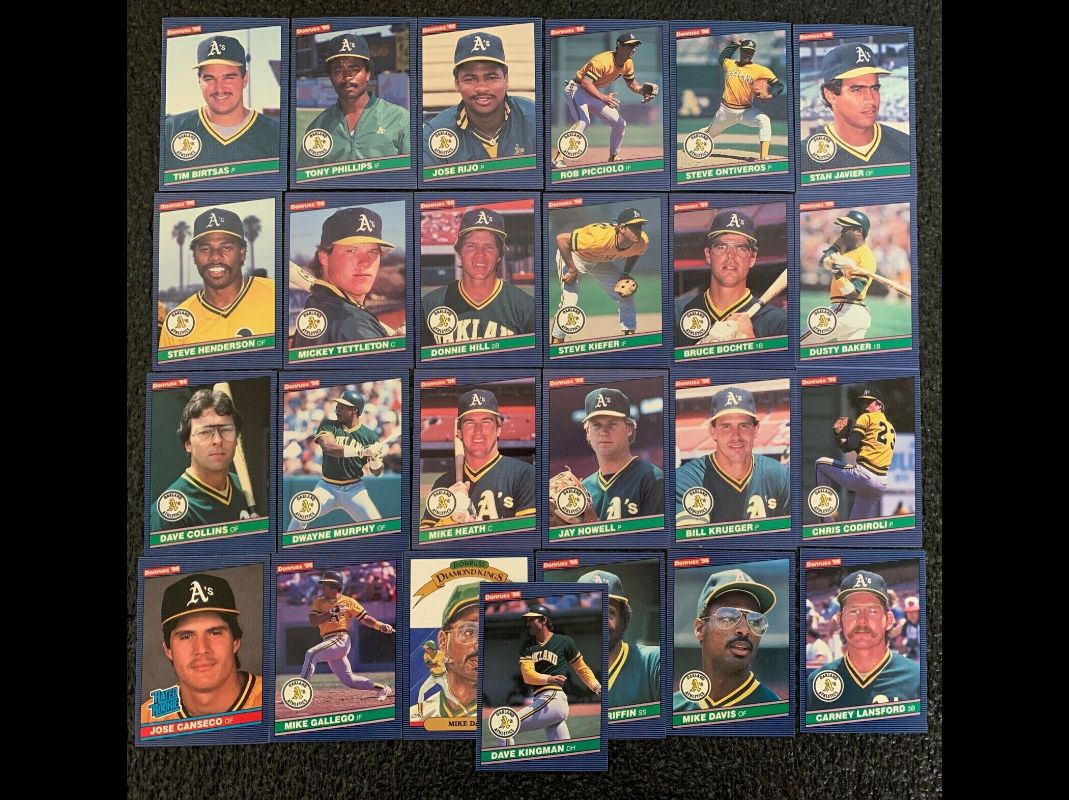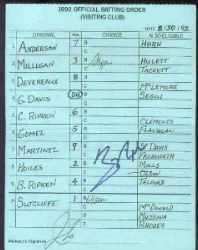A'S - 1986 Donruss - COMPLETE Team Set (24)
Jose Canseco ROOKIE, Dusty Baker, Dave Kingman, Mickey Tettleton...
| Grade |
NM/MINT |
| Book Value |
n/a |
| Our Price |
$ 17.95
Add to cart
|


Below are short bits & pieces on sportscard & baseball trading card collecting.
Please wander around the website for more info, prices, values & images
on vintage baseball, football, basketball, hockey, sport and non-sports cards.
Authentic Major League SIGNED
Game-Used LINEUP Cards (PSA)

These are the official lineup cards SIGNED BY THE MANAGER & given
to the home plate umpire before the game with the team's line-up
& batting order !!! Making them even neater, often managers made
lineup changes on these cards throughout the game.
These official lineup cards were SIGNED BY THE MANAGER and presented
to the home plate umpire before the game. They detailed the team's lineup and
batting order. Managers often made lineup changes on these cards throughout
the game, making them even more unique.
Collectors say "They are official documents of a particular game, so they are
absolutely historically relevant. The manager, he was the general in the war.
Imagine owning Eisenhower's list of who he wanted to go into battle, and then he
signed it !!! Imagine what that would be worth?"
The first dugout lineup cards were seen around 1960. Along with lineup
cards, most ended up in the trash after games, making them quite rare today.
MLB saw the light and started marketing them directly in the 2000's.
Astronomical prices have been paid for cards from special games.
$165,010 for the Red Sox dugout lineup card from Game 4 of the 2004 World Series.
$138,000 in 2007 for 1st ever All-Star Game batting order cards.
$ 40,000 for batting order cards and the pen used to fill them out from
Cal Ripken's 2,130th & 2,131st games.
Click for complete
Major League SIGNED Game-Used LINEUP cards
Note: You may be on that page right now.
|

1954 Quaker Oats Sports Oddities
Checklist & Values
The 27-card 1954 Quaker Oats Sports Oddities multi-sport set was
available card by card in boxes of Quaker Oats "Puffed Wheat and Rice"
or if you weren't patient, you could purchase a complete set through
the mail for all of 15 cents and two box tops from Quaker Puffed
Wheat or Quaker Rice !!!
The very colorful cards measured 2-1/4 x 3-1/2 inch and came with rounded
corners honoring special moments in sports history. Each card featured
a portrait and action illustration.
Click for complete
1954 Quaker Oats Sports Oddities card values and prices
Note: You may be on that page right now.
|

1933 Goudey Baseball Cards
Checklist & Values
1933 Goudey baseball cards were issued during the worst part of
The Great Depression. The set ended up at 240 cards (239 printed
in 1933 and one in 1934). In an effort to attract collectors,
several of the games top players were honored with multiple cards
including "The Great Bambino" who appeared on 4 different cards.
The Babe was once asked why he made more than the President of the
United States, the Babe answered simply: "I had a better year than he did."
The Elusive Nap Lajoie
One of the most important facts regarding the 1933 Goudey set was their
infamous marketing ploy. Goudey took "marketing" to a whole new level
to keep people buying packs by never issuing card #106. Collectors wrote
the Goudey Card Company complaining. They were rewarded with Goudey
sending them the un-issued card #106 (Nap Lajoie) in 1934.
Note: You may be on that page right now.
|

Tobacco Cards
Starting approximately in 1886, sportscards, mostly baseball cards, were often
included with tobacco products, for promotional purposes and also because the
card reinforced the packaging and protected cigarettes from damage. These sports
cards are referred to as tobacco cards in the baseball card hobby. Over the next
few years many different companies produced baseball cards. Tobacco cards soon
started to disappear as the American Tobacco Company tried to develop a monopoly
by buying out other companies.
They were reintroduced in the 1900s, as American Tobacco came under pressure from
antitrust action and Turkish competition. The most famous and most expensive,
baseball card is the rare T206 Honus Wagner. The card exists in very limited
quantities compared to others of its type because Wagner forced the card to be
removed from printing. It is widely (and incorrectly) believed that Wagner did
so because he refused to promote tobacco, but the true explanation lies in a
dispute over compensation.
Soon other companies also began producing baseball and football cards. Sports magazines
such as The Sporting News were early entries to the market. Candy manufacturers
soon joined the fray and reflected a shift toward a younger target audience for cards.
Caramel companies were particularly active and baseball cards were one of the first
prizes to be included in Cracker Jacks. World War I soon suppressed baseball card
production.





 These are the official lineup cards SIGNED BY THE MANAGER & given
to the home plate umpire before the game with the team's line-up
& batting order !!! Making them even neater, often managers made
lineup changes on these cards throughout the game.
These official lineup cards were SIGNED BY THE MANAGER and presented
to the home plate umpire before the game. They detailed the team's lineup and
batting order. Managers often made lineup changes on these cards throughout
the game, making them even more unique.
These are the official lineup cards SIGNED BY THE MANAGER & given
to the home plate umpire before the game with the team's line-up
& batting order !!! Making them even neater, often managers made
lineup changes on these cards throughout the game.
These official lineup cards were SIGNED BY THE MANAGER and presented
to the home plate umpire before the game. They detailed the team's lineup and
batting order. Managers often made lineup changes on these cards throughout
the game, making them even more unique.
